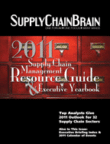
Visit Our Sponsors |
|
|
|
|
|
|
|
|
|
|
|
|
|
|
|
|
|
|
|
|
|
|
|
|
|
|
|
|
|
|
|
|
|
|
|
|
|
|
|
|
|
|
|
|
|
|
|
|
|
|
|
|
|
|
|
|
|
|
|
|
|
|
|
|
|
|
|
|

Analyst Insight: The No. 1 goal for consumer products companies is growth, but IT and supply chain strategies are focused on reducing costs and improving efficiency. Over the last ten years, this mismatch in spending versus priorities has never been greater.
--Lora Cecere, industry analyst, Altimeter Group
Power is rapidly shifting in the channel from the retailer to the shopper, and companies are quickly crafting strategies to use social technologies to build a relationship directly with the digital consumer. This includes the rise of social commerce (use of social platforms to power new forms of commerce), the redefinition of customer service through Twitter and Facebook platforms, and the direct linkage of the consumer to open innovation networks through social media. It is no longer acceptable to be social only for the reason of being social. Consumer products companies are quickly realizing that they can forge new and more powerful relationships directly with the consumer and accelerate time to market, and better manage the long tail of the supply chain.
As the power shifts, the ante is raised on demand-driven strategies. Demand-driven strategies effectively balance the goals of efficiency and growth initiatives. Companies recognize that being demand-driven - sensing and responding to demand with near-zero latency - minimizes waste and enables revenue growth while minimizing costs. However, the movement to embrace demand-driven principles has been delayed by change management issues.
The primary issue is the movement from supply chain thinking - where the focus is minimizing costs in supply - to value chain thinking where companies connect from the customers' customer to the supplier's suppliers to translate and orchestrate demand through demand shaping programs: price, promotions, marketing programs and sales incentives. There are four major hurdles:
• Traditional definition of sales and marketing roles. For demand-driven programs to become a reality, they have got to extend across the commercial teams and become an integral piece of the definition of demand-driven relationships.
• Alignment of incentives to maximize value (this is impossible when the sales organization is primarily incented on volume, marketing on market share and supply chain on costs).
• Building of horizontal processes to move from reacting to orchestrating the demand signal through price, promotions, new product launch and sales incentives. To be effective, demand orchestration balances demand opportunities with supply-side risks and strategies.
• Traditional definition of supply chain. Moving from a supply focus of right product, right place, and right time to a value chain focus requires a redefinition of goals to define what is the right balance for cost, growth, corporate sustainability metrics, and cash-to-cash measurements. Companies have to define how many supply chains exist and actively design the value networks to maximize value. This is a very different role than the traditional supply chain function.
• The movement from a vertical siloed orientation to building horizontal processes for new product launch, sales and operations planning, revenue management, and supplier development. The movement from a vertical focus to a horizontal process and reward system is a major change for most companies.
The Outlook
In parallel, companies are realizing that their investments in enterprise resource planning have improved efficiency but not flexibility. As a result, in 2011, the market will experience an ERP hangover. Major ERP vendors will struggle to meet Wall Street estimates and there will continue to be an onslaught of merger and acquisitions between the business intelligence and ERP transactional software markets. To overcome this hurdle, look for companies to invest in enterprise data warehouse technologies and build enterprise data models, new forms of predictive analytics that sense and respond and better use downstream data, and advanced analytics to better use data in existing systems.
RELATED CONTENT
RELATED VIDEOS
Timely, incisive articles delivered directly to your inbox.






